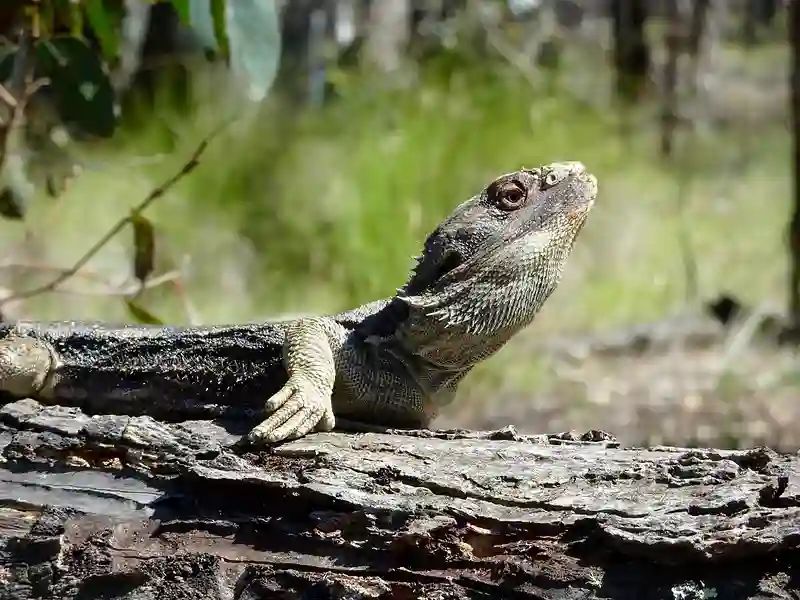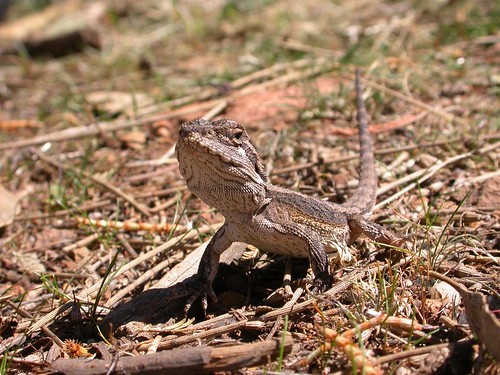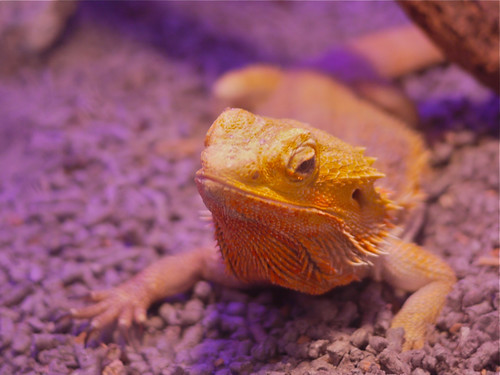Bearded dragons (Pogona vitticeps) are fascinating reptiles that are native to Australia. They are commonly found in a variety of habitats, including deserts, woodlands, savannas, and scrublands. Understanding their natural habitat is crucial for their proper care in captivity.
In the wild, bearded dragons are semi-arboreal, meaning they spend a significant amount of time on the ground but also climb trees and shrubs. They are often seen basking on rocks or branches to regulate their body temperature.
These reptiles are also skilled burrowers, using their strong limbs and claws to dig tunnels in the sand or soil for shelter and protection.
Their diet is omnivorous, consisting of both plant matter and animal protein.
Natural Habitats of Bearded Dragons
Bearded dragons are native to Australia and can be found in a variety of natural habitats. These include Australian deserts, which are characterized by hot and arid conditions, making them ideal for the reptiles’ ability to regulate their body temperature.
Rocky outcrops provide shelter and basking spots, while sandy plains offer a soft substrate for burrowing. Grasslands are home to a variety of insects and vegetation, which form part of the bearded dragon’s diet.
Finally, scrublands provide a mixture of vegetation and open spaces, allowing the dragons to bask, hunt, and seek shelter.
Australian Deserts
Desert habitats are a significant part of the natural environment for bearded dragons. These reptiles have adapted to the harsh conditions of the Australian deserts, where they can be found thriving. The deserts provide bearded dragons with the perfect combination of heat, dryness, and limited vegetation.
In these arid regions, bearded dragons have developed specialized behaviors and physical characteristics to survive. They are skilled at burrowing in the sand to escape extreme temperatures and predators.
Camouflage is another crucial adaptation that allows them to blend seamlessly with their surroundings. Bearded dragons in the Australian deserts primarily feed on insects, small reptiles, and vegetation that can survive in these challenging conditions.
Rocky Outcrops
Rocky outcrops are another natural habitat where bearded dragons can be found in the wild. These outcrops, which are large rock formations, provide the perfect environment for these reptiles to thrive. Bearded dragons are known to climb and bask on the rocks, soaking up the warmth from the sun.
Within the rocky outcrops, there is a diverse range of vegetation that provides food and shelter for the dragons. This includes shrubs, cacti, and small trees that grow in the crevices of the rocks. These plants create a microhabitat where the bearded dragons can find insects and small vertebrates to eat.
Sandy Plains
Moving on to the next natural habitat of bearded dragons, we explore the intriguing sandy plains. These vast expanses of sandy terrain provide an ideal environment for these reptiles to thrive.
The sandy plains offer a unique set of challenges and opportunities for bearded dragons, making them adapt and survive in this harsh environment.
In these sandy plains, bearded dragons have learned to utilize their camouflage skills to blend seamlessly with their surroundings, ensuring their safety from potential predators.
The sandy coloration of the dragons’ skin allows them to remain inconspicuous among the sandy dunes, providing them with a distinct advantage.
Within the sandy plains, bearded dragons have also developed burrowing behaviors.
Adaptations for Survival
Adaptations for survival are crucial for the survival of different species in various environments. One key adaptation is camouflage, which allows animals to blend in with their surroundings, enabling them to hide from predators or sneak up on prey.
Another important adaptation is burrowing, where animals create underground tunnels as a way to escape harsh weather conditions or predators.
Water conservation is another adaptation, as animals in arid environments have the ability to minimize water loss and efficiently use the water they obtain.
Camouflage
Now that we have explored the natural habitats of Bearded Dragons, let’s delve into the remarkable adaptations these fascinating creatures possess to ensure their survival.
One of the most impressive adaptations of Bearded Dragons is their ability to camouflage. Camouflage allows these reptiles to blend seamlessly into their surroundings, enhancing their chances of avoiding predators and capturing prey.
To achieve effective camouflage, Bearded Dragons have developed unique color patterns and textures that closely resemble their environment. Their scales can mimic the colors of the rocks, sand, and vegetation in their habitat, making it difficult for predators to spot them.
Burrowing
After exploring the natural habitats of bearded dragons, it’s fascinating to delve into their adaptations for survival in these environments. One significant adaptation is their ability to burrow, which provides them with various advantages.
Burrowing:
- Bearded dragons have strong limbs and sharp claws that enable them to dig burrows in the ground.
- These burrows serve as a safe haven, protecting them from predators and extreme temperatures.
- The burrows also offer a place to lay eggs, ensuring the survival of future generations.
Bearded dragons’ burrowing behavior showcases their remarkable ability to adapt to their surroundings. By burrowing, they can regulate their body temperature, find shelter, and protect themselves from potential threats.
Water Conservation
In addition to their natural habitats and adaptations for survival, Bearded Dragons also possess remarkable abilities to conserve water. This is crucial for their survival in arid environments where water is scarce.
Water conservation is achieved through several mechanisms that allow these reptiles to minimize water loss and maintain hydration.
- One of the key strategies employed by Bearded Dragons is the ability to concentrate their urine. This is achieved by filtering waste products and reabsorbing water back into their bodies, thus minimizing the amount of water lost in the excretory process.
- Another mechanism is the reduction of respiratory water loss.
Reproduction in the Wild
Reproduction in the wild involves a range of fascinating behaviors and adaptations that ensure the continuation of species. Mating behavior and rituals play a crucial role in the selection of mates, with various species engaging in elaborate courtship displays and communication to attract partners.
Understanding female reproductive cycles and ovulation is essential for successful reproduction, as it allows for optimal timing of mating. Additionally, nesting and egg-laying behavior is a critical aspect of reproduction, as it ensures the survival of offspring.
Mating Behavior and Rituals
In the wild, animals have evolved various strategies to ensure their survival. From camouflage to mimicry, they have developed remarkable abilities that allow them to thrive in their respective environments.
However, survival is just one aspect of their lives. Reproduction is equally important, and animals have also developed unique behaviors and rituals to ensure the successful continuation of their species.
Mating behavior and rituals play a crucial role in the reproductive success of animals. These behaviors serve several purposes, including attracting a mate, establishing dominance, and ensuring the compatibility of potential partners.
Different species have their own unique mating rituals, which can range from elaborate courtship dances to vocal displays.
Courtship Displays and Communication
Courtship displays and communication are crucial aspects of reproductive behavior in the animal kingdom. These behaviors serve to attract potential mates, establish dominance, and ensure successful mating.
Courtship displays can include a wide range of behaviors, such as elaborate dances, impressive vocalizations, and colorful displays of plumage or other physical features. These displays not only showcase the individual’s physical attributes but also signal their fitness and genetic quality to potential mates.
Communication during courtship is equally important. Animals utilize various signals and cues to convey their intentions and readiness to mate. These can include visual displays, such as specific postures or movements, as well as auditory signals like songs or calls.
Female Reproductive Cycles and Ovulation
Female reproductive cycles and ovulation are fascinating aspects of animal behavior that play a crucial role in ensuring the continuation of a species. Understanding these cycles is essential for studying and conserving wildlife populations.
- Female reproductive cycles: In many species, females go through reproductive cycles that involve distinct phases. These cycles are regulated by hormones and can vary greatly between species.
- Ovulation: Ovulation is the release of a mature egg from the ovary and is a key event in the reproductive cycle. Ovulation can be triggered by various factors, including hormonal changes, environmental cues, or the presence of a male.
Predators of Bearded Dragons
Predators of bearded dragons include a range of formidable creatures, such as monitor lizards, goannas, snakes, and birds of prey. These predators pose a significant threat to the survival of bearded dragons in their natural habitats.
Monitor lizards and goannas are known for their strong jaws and sharp teeth, capable of inflicting severe injuries. Snakes are skilled hunters, using their stealth and venom to overpower their prey. Meanwhile, birds of prey have keen eyesight and powerful talons, making them swift and efficient hunters.
Monitor Lizards
Bearded dragons have a remarkable ability to reproduce in the harsh conditions of the wild. However, their journey to adulthood is fraught with challenges, as they are constantly hunted by a range of predators.
One such predator is the monitor lizard, a formidable reptile known for its fierce hunting skills. Monitor lizards, also known as goannas, are opportunistic predators that can grow up to 2 meters in length. They have a keen sense of smell and can detect the presence of bearded dragons from a distance.
When a monitor lizard spots a bearded dragon, it uses its incredible speed and agility to chase down its prey. Once caught, the lizard will use its sharp teeth and powerful jaws to deliver a fatal bite.
Goannas
In the wild, bearded dragons face a variety of predators that pose a threat to their survival. One of the most formidable predators of bearded dragons is the goanna, a type of monitor lizard found in Australia. Goannas are known for their impressive size, reaching lengths of up to 7 feet.
These powerful reptiles have sharp claws and a strong bite, making them capable hunters. When hunting bearded dragons, goannas use their keen sense of smell to detect their prey.
Once located, they rely on their speed and agility to chase down their target. Goannas are skilled climbers and can easily scale trees and rocks in pursuit of their meal. They are also excellent swimmers, allowing them to hunt for bearded dragons near bodies of water.
Conclusion
In conclusion, bearded dragons thrive in a variety of natural habitats in the wild in Australia. From deserts to woodlands, savannas to scrublands, they have adapted to survive in diverse environments.
Their semi-arboreal nature allows them to bask in the sun while also being capable of burrowing to escape extreme temperatures. As omnivorous creatures, they consume a mix of vegetation, invertebrates, and small vertebrates, ensuring their nutritional needs are met.
To ensure their survival, bearded dragons have developed adaptations such as their unique beard display, which they use to communicate and establish their territorial boundaries.


